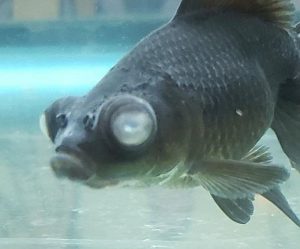Cloudy Eye disease is a condition that occurs in both tropical fish keeping aquariums and pond fish. In many scenarios is is not actually a disease, but a symptom associated with other diseases. The eyes of the fish become cloudy to the point of becoming white and without treatment, loss of vision will usually occur. The good news about this condition is that it is relatively rare and not fatal when promptly treated.
PHYSICAL SYMPTOMS:
Cloudy Eye is identified when a cloudy white or gray haze is observed on one or both eyes of the fish. The fish can show signs of distress, abnormal behavior, be off color, and in the worst case scenario, demonstrate loss of vision.
CAUSE:
Cloudy Eye can by caused by several factors which make it difficult to identify. When rare fatalities do occur, it is usually due to untreated secondary fungal, parasitic, or bacterial infections during latter stages. That being said, poor water quality is usually the most common culprit. Elevated levels of nitrites, nitrates, ammonia, chlorine, chlormine, excessive salinity, frequent water temperature fluctuations, and pH shock may all cause the eyes of fish to become cloudy in ponds and aquariums. Overcrowding, bullying, and stress can also exacerbate the condition causing a reduction of slime over the eye.
TREATMENT:
Once the underlying cause for Cloudy Eye is determined, the best treatment in most cases is to make regular water changes to the tank. When possible, the addition of salt is helpful, especially in the early stages of the condition.
- The first step is to check the fish for symptoms of another illness like velvet, ich, or tuberculosis that can be treated with medications.
- If no other illnesses are apparent, check the tank water for temperature, pH, the presence of nitrites, nitrates, and ammonia.
- Correct any water quality disparities and perform regular water changes. Add salt if possible.
- If the Cloudy Eye is the result of a bacterial infection, treat with KanaPlex
or ParaGuard
, Furan-2
, Melafix
, or other over the counter bacterial medication. If the fish does not respond, switch to SulfaPlex
.
PREVENTION:
Anything that weakens the immune system can cause Cloudy Eye disease in freshwater and marine tropical fish. This includes poor water quality, fluctuations in water parameters, constant stress, bullying from tank mates, malnutrition, using dirty nets, etc.
- Maintain a clean aquarium by performing regular water changes and testing to prevent bacteria buildup that can weaken the immune system.
- Regular water changes are a critical part of tank maintenance. Water changes done improperly can do more harm than good. Sudden temperature changes during a water change can often worsen the Cloudy Eye condition.
- Use a quality water conditioner to eliminate chlorine and Chloramine in the tap water.
- Don’t overcrowd your tank. Fish waste builds up quickly even with the best of filtration systems.
- Don’t overfeed your fish. Small quantities of quality foods fed two or three times daily is preferable to a single feeding and minimizes waste buildup. Your fish should consume whatever you feed them within 5 minutes and any uneaten food should be removed from the tank.
- Only keep compatible species in a community tank environment. Watch new additions for bullying or fin nipping and separate them when necessary.
- Always quarantine new fish before placing them in a community tank. It is easier to spot and treat fish diseases in a quarantine tank than in a community environment.
*Melafix is a natural wide range antibiotic formulated to heal a wide variety of mild gram positive bacterial infections like tail and fin rot, eye cloud, mouth fungus and more. **Pimafix quickly treats fungal and bacterial infections such as cottony growth, fin and tail rot, etc.



One Response to “Cloudy Eye”
Trackbacks/Pingbacks
[…] Cloudy Eye […]